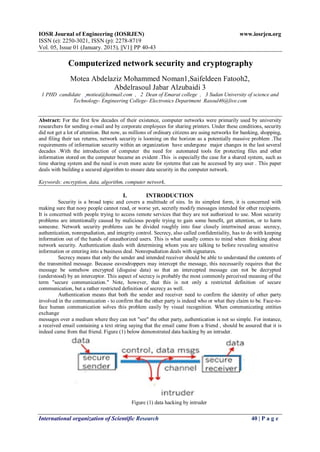This document discusses computer network security and cryptography. It begins with an introduction to the increasing importance of network security as ordinary users conduct banking and other sensitive activities online. It then describes the key aspects of network security - secrecy, authentication, nonrepudiation, and integrity control. The document goes on to present the design of a system to demonstrate encryption and decryption processes for securing data exchange between computers connected over an RF network. It describes the hardware and software components, including the encryption algorithm which performs XOR operations on data bytes with a table of ASCII encoded bytes. Test results are shown indicating the encrypted bytes output for various plain text bytes. The system is concluded to enable flexible encryption of data transmission with a high degree of security.



![Computerized network security and cryptography
International organization of Scientific Research 43 | P a g e
VI. CONCLUSION
The system design that enabled the data encryption and transmission adapted a non standard
encryption strategy. The number of bytes in the generated ASCII code table equals four bytes while the
assumed number of bytes in the plain text equals hundred..The assumed byte numbers in the two tables can be
changed as well as the gate used in the algorithm .This means that the strategy is flexible and any change will
not affect its principle .This type of encryption carries a high degree of data transmission security.
REFERENCES
[1] C. Gentry, Fully homomorphic encryption using ideal lattices, Symposium on the Theory of Computing
(STOC), 2009, pp. 169-178.
[2] P. Paillier, Public-key cryptosystems based on composite degree residuosity classes, in Advances in
Cryptology EUROCRYPT’99, LNCS 1592, pp. 223–238,
[3] Springer, New York, NY, USA, 1999.
[4] Josh Benaloh, Dense Probabilistic Encryption, SAC 94, pages 120–128, 1994.
[5] I. Damg˚ard and M. Jurik. A Length-Flexible Threshold Cryptosystem with Applications.ACISP ’03, pp.
350–356.
[6] A. Kawachi, K. Tanaka, K. Xagawa. Multi-bit cryptosystems based on lattice problems. PKC ’07, pp.
315–329.
[7] C.A. Melchor, G. Castagnos, and P. Gaborit. Lattice-based homomorphic encryption of vector spaces.
ISIT ’08, pp. 1858–1862.
[8] Craig Gentry Shai Halevi, Implementing Gentry’s Fully-Homomorphic Encryption Scheme Preliminary
Report, August 5, 2010. https://researcher.ibm.com/ researcher/files/us-shaih/fhe-implementation.pdf
[9] Frederiksen, T.K., A Practical Implementation of Regev’s LWE-based Cryptosystem,2010.
[10] William Stallings, Cryptography and Network Security Principles and Practice, 5th Edition , Prentice
Hall , 2011.](https://image.slidesharecdn.com/g05114043-150211222433-conversion-gate01/85/G05114043-4-320.jpg)